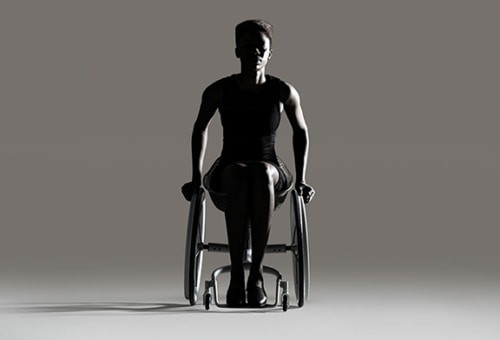New 3-D Printed Wheelchair Promises “Perfect Fit” for Users
June 20, 2016
Maureen GazdaFor many wheelchair users, finding a comfortable chair can feel like searching for Cinderella’s glass slipper. Enter London based designer Benjamin Hubert, who hopes to be our Prince Charming.
Hubert and his design agency, Layer, debuted GO, the world’s first fully customizable 3-D printed wheelchair, at London’s Clerkenwell design week last month.
The prototype, created in collaboration with 3-D printing company Materialise, is constructed of semi-transparent resin, thermoplastic polyurethane plastic and titanium.
“It’s like molding something to the body rather than measuring something with a ruler,” said Hubert. “There’s a huge degree of accuracy that we’re gaining by ultimately just offsetting the body’s shape and emulating that in the seat.”
A trailblazer in the design world, Hubert is well-known for his eclectic furniture pieces, but this is his is first venture into designing wheelchairs. His goal is to showcase what he sees as the many flaws and limitations of traditional wheelchairs by creating a more comfortable chair that is perceived as a sleek, attractive vehicle, rather than a medical device.
GO wheelchair from Benjamin Hubert on Vimeo.
3-D Printing Could Be Beneficial
While they may appreciate the streamlined design of the chair, many rehab professionals are skeptical of its practicality. Also, they say the medical necessity aspect cannot be ignored, especially when it comes to insurance.
“If we say the wheelchair is no longer a medical device we could lose precious and hard-fought footing for payment through medical insurance,” said occupational therapist Debra Stemmler, who is a wheelchair user. “Although 3-D printing is becoming more affordable there still has to be a mechanism for evaluation, device purchase and final fitting process, which is currently funded through medical insurance. So not only is the equipment paid for by medical insurance, but the evaluation and fitting visits are paid for also. If you take it out of that medical coverage area then you may limit access for some of the most compromised populations whose only funding is medical insurance.”
Despite this, Stemmler says the unique molding method could be useful in ensuring a new wheelchair fits properly.
“Where I see a potential benefit is in the custom molding process,” says Stemmler, who lives in Pittsburgh. “A similar scanning and molding process is used where a seat is molded to fit someone’s body shape. This is a cumbersome and time-consuming process that could be improved with this new technology. I would recommend finding ways this technology could be incorporated into the process, but not replace it.”
No word on what the chair will cost, the process or getting one, or if insurance will cover it, but it is set to be available for purchase on the Layer agency app in the coming weeks.
Support New MobilityWait! Before you wander off to other parts of the internet, please consider supporting New Mobility. For more than three decades, New Mobility has published groundbreaking content for active wheelchair users. We share practical advice from wheelchair users across the country, review life-changing technology and demand equity in healthcare, travel and all facets of life. But none of this is cheap, easy or profitable. Your support helps us give wheelchair users the resources to build a fulfilling life. |



Recent Comments
Bill on LapStacker Relaunches Wheelchair Carrying System
Phillip Gossett on Functional Fitness: How To Make Your Transfers Easier
Kevin Hoy on TiLite Releases Its First Carbon Fiber Wheelchair